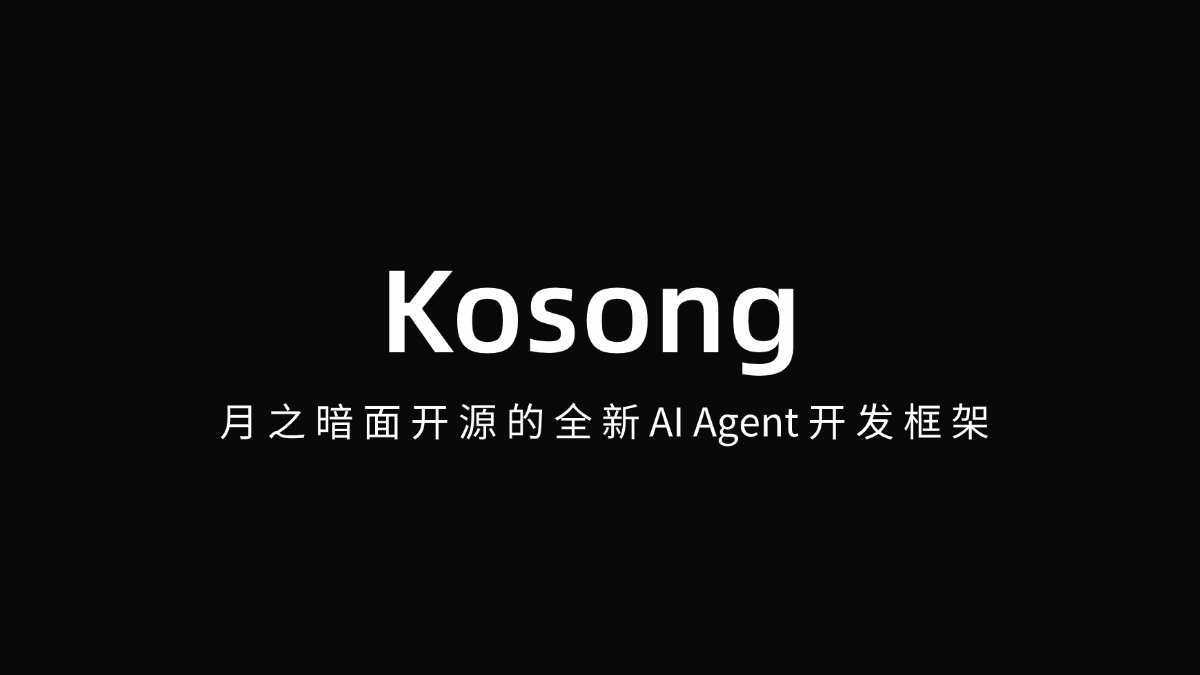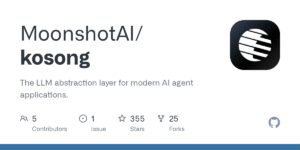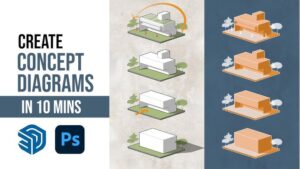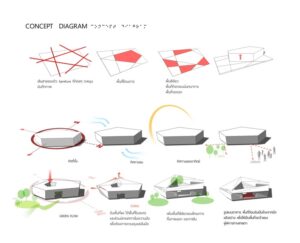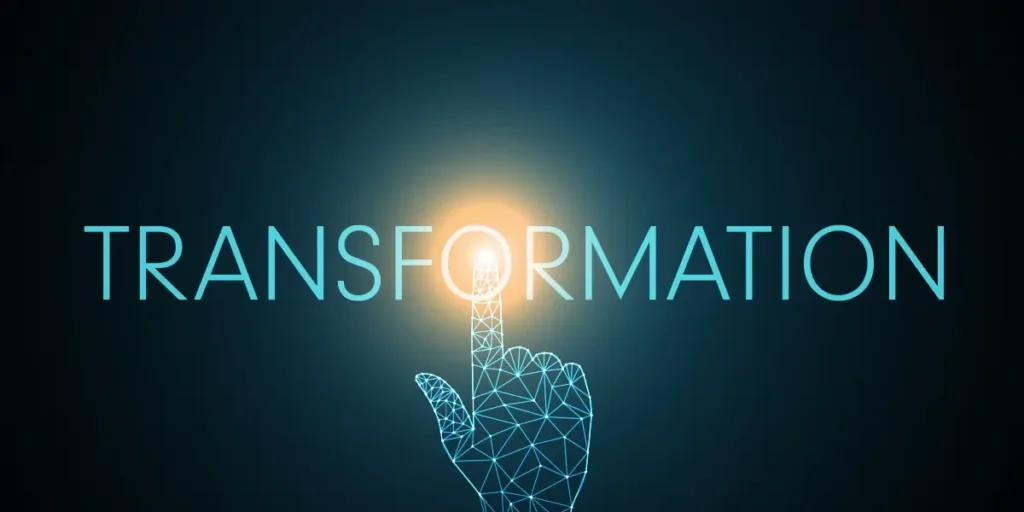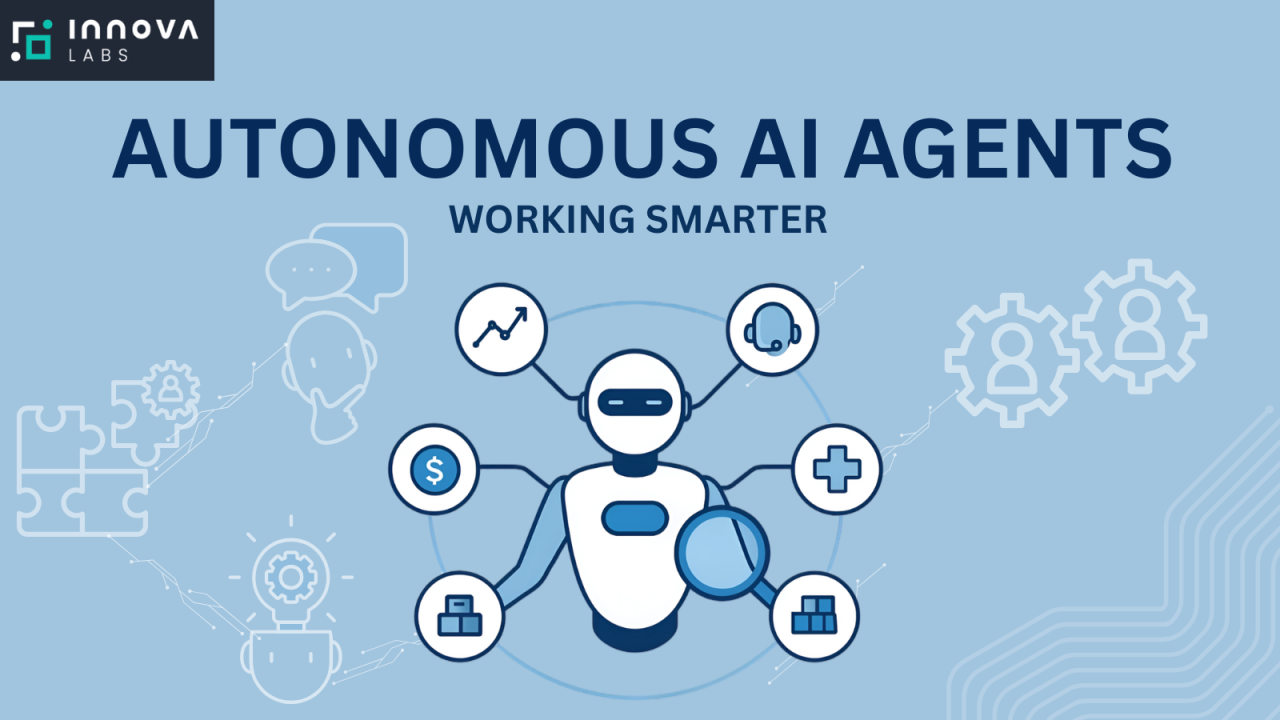📢 Introduction: A Milestone from Moonshot AI
In a notable move within the AI-tooling ecosystem, Moonshot AI has officially released Kosong — an open-source abstraction layer designed to streamline interactions with large language models (LLMs) and tools for agent-driven applications. This announcement arrives at a time when development teams are increasingly navigating multi-model stacks, tool orchestration, and vendor lock-in risks. According to the GitHub repository, Kosong is “the LLM abstraction layer for modern AI agent applications” and aims to unify message structures, asynchronous tool orchestration and pluggable chat providers. GitHub
In this article, we’ll explore what Kosong is, why it matters, how it works, key features and benefits, potential use-cases, challenges, and what it could mean for AI development going forward.
Why Kosong? The Context & Need
Modern LLM-based systems and AI agents face a number of engineering and architectural headwinds:
1. Multi-model and multi-provider complexity
With more organizations offering LLM APIs (open-source frameworks, proprietary models, etc.), building an agent that can flexibly switch between models — or chains of models — becomes non-trivial. Kosong’s promise is to offer a unified abstraction so developers aren’t locked into one vendor or forced to build custom glue code.
2. Tool orchestration & asynchronous workflows
Agentic systems increasingly combine: user prompt → model reasoning → tool invocation (e.g., search, database lookup, calculator) → model again. Handling asynchronous tool calls, interleaving messages, streaming responses, and tool results can be messy. Kosong explicitly mentions support for asynchronous tool orchestration. GitHub
3. Message format and structure standardisation
Different model providers sometimes expect different message formats (system/user/assistant roles, tool call schemas, etc.). Standardising around one message abstraction layer means fewer integration headaches and more reusability.
4. Avoiding vendor lock-in
If you code deeply against one provider’s SDK or message flow, switching later can be painful. By building on an abstraction layer like Kosong, you can decouple your agent logic from model/provider specifics.
5. Open-source ecosystem momentum
Moonshot AI open-sourcing Kosong aligns with the trend of making more agent-tooling and infrastructure pieces publicly available — enabling faster adoption, community contributions and shared best practices.
Given these background pain-points and trends, Kosong enters at the right time.
What Is Kosong? A Technical Overview
Definition
From the official repository:
“Kosong is an LLM abstraction layer designed for modern AI agent applications. It unifies message structures, asynchronous tool orchestration, and pluggable chat providers so you can build agents with ease and avoid vendor lock-in.” GitHub
Interestingly, the repository notes that “Kosong means ‘empty’ in Malay and Indonesian.” — possibly signifying the blank canvas or flexible foundation it aims to provide.
Key Components
Here are some of the major building blocks:
-
Chat provider plug-ins: As examples, the repo shows integration with a “Kimi” chat provider (Moonshot’s own model offering) via a
Kimiclass that implements achat_providerinterface. GitHub -
Message abstraction: A
Messagetype (role + content) is used to represent user/system/assistant messages in a standardized way. History of messages is maintained. GitHub -
Tools / Toolsets: Definition of
CallableTool2,ToolOk,ToolReturnType, etc., enabling you to define tools (with names, descriptions, parameter models) that your agent can call. Example shows anAddToolthat adds two integers. GitHub -
Streaming support: The example usage shows
on_message_part=output, indicating part-streaming of responses (useful for real-time agents). GitHub -
Async orchestration: The
generateandstepfunctions are async, meaning they integrate with Python’sasyncioecosystem. This is important for handling I/O bound tasks (tool calls, API calls) in agents.
Getting Started (Installation)
From the README:
(“uv” appears to be a package manager or alias used by Moonshot’s ecosystem) GitHub
Simple Chat Example
This shows how one can wrap a model provider (Kimi) behind Kosong, feed in a message history, and invoke generation. GitHub
Tool-Calling Example
Continuing the example:
Then the code shows how the agent steps by passing the toolset and obtaining tool results together with message results. GitHub
What Makes Kosong Stand Out: Features & Benefits
Here are some of the standout features of Kosong — and the benefits they bring.
✅ Unified Abstraction Layer
By providing a consistent interface for chat providers, message formats, and tools, Kosong allows developers to write agent logic once and switch underlying model providers with minimal changes. For teams building for scale and variety (many models, many tool integrations), this is a major win.
✅ Asynchronous Tool Orchestration
In agent workflows, you often need to call external tools (e.g., search, database queries, calculators) while managing message flow. Kosong supports async workflows out-of-the-box. This reduces engineering friction and helps ensure responsive interactive agents.
✅ Streaming Support
Streaming responses (token-by-token or chunk by chunk) are increasingly common in chat/agent applications to improve perceived latency and interactivity. Kosong’s support for streaming helps build smoother UX.
✅ Pluggable Chat Providers
Whether you use Moonshot’s “Kimi” model, another API, or your in-house LLM, you can plug it into Kosong’s provider interface. This means you’re not locked into a specific vendor and can experiment, switch, or upgrade easily.
✅ Tool-First Agent Workflow
Kosong’s design acknowledges tool use (rather than purely “chat responses”) as first-class. This is aligned with current “agentic” design patterns where the model orchestrates tools. Having tooling built into the abstraction helps accelerate development.
✅ Open-Source with Apache-2.0 License
The repository is licensed under Apache-2.0, which is permissive and suitable for commercial use. GitHub Open-sourcing the layer helps build community, contributions, trust, and wider adoption.
✅ Accelerated Agent Development
For teams working on conversational AI, assistants, autonomous agents, or workflows involving LLMs and tools, Kosong reduces boilerplate and provides a foundational framework. Instead of building message-handling + tool orchestration plumbing from scratch, you can focus on the higher-level logic and domain-specific tasks.
Use Cases: Where Kosong Can Be Applied
Here are some scenarios where Kosong becomes especially relevant.
1. Enterprise Assistant / Agent Platforms
Large organisations building internal assistants (for HR, IT help-desk, data-insights) often integrate search tools, internal knowledge bases, calculators, workflows. Kosong allows them to abstract away model-specific plumbing and focus on domain logic.
2. Multi-Model Experimentation Platforms
Research teams or commercial teams experimenting with different LLMs (open source vs commercial) can wrap those under Kosong and benefit from switchable back-ends. This simplifies A/B testing, vendor migration, or model upgrades.
3. Tool-Oriented Chatbots
Agents that heavily rely on external tools (APIs, databases, workflow systems) — e.g., travel booking agents, analytics assistants, dev-ops automation bots — will benefit from Kosong’s built-in tool orchestration support.
4. Streaming Chat Interfaces
Applications where latency and real-time interactivity matter (e.g., customer support chatbots, developer assistants) can use Kosong’s streaming support to provide responses as the model is generating, improving UX.
5. Open-source Agent Frameworks
Startups and open-source projects building agent frameworks can adopt Kosong as a foundational layer, building domain-specific logic on top. This accelerates time to market and community adoption.
Challenges and Considerations
While Kosong shows strong promise, there are some important considerations and limitations to keep in mind.
⚠️ Maturity and Ecosystem
While the repository is active (recent commits) and has traction (stars/forks) — e.g., 355 stars and 25 forks as of last check. GitHub However, compared to more mature SDKs or frameworks (like LangChain, LlamaIndex, etc.), Kosong may have fewer integrations, fewer community-plugins, and less battle-testing in production. Teams should evaluate stability and support.
⚠️ Model Provider Support
The initial plug-in example in the README shows integration with Moonshot’s “Kimi” model API. For other model providers (OpenAI, Anthropic, local LLMs), you’ll need to implement provider adapters or check if community has done so. If not, there may still be integration work required.
⚠️ Tool Complexity and Workflow Customisation
Agent workflows can become complex (multi-step reasoning, tool chaining, fallback logic, error handling). While Kosong provides base abstractions, teams will still need to design their tool orchestration logic, error handling, retry logic, safety, and monitoring.
⚠️ Asynchronous Event-Driven Systems
Async frameworks (Python’s asyncio) bring benefits but also complexity (debugging, concurrency, resource management, streaming). Teams less familiar with async programming might have steeper learning curves.
⚠️ Performance, Scaling and Cost
Although Kosong handles the abstraction layer, the underlying model usage, tool API calls, orchestration overhead, latency, and cost remain real-world constraints. Teams building at scale must still monitor performance, cost per query, and infrastructure.
⚠️ Governance, Safety & Compliance
As with any agent framework, using Kosong doesn’t absolve you from designing for safety, governance, bias mitigation, audit trails and compliance. These still need to be layered in on top of the abstraction.
Strategic Implications: What Kosong Signals for the AI Landscape
The release of Kosong carries significance beyond just a new open-source tool. Here are some wider strategic implications.
🌐 Growth of Agent Infrastructure Layer
Historically, much of the LLM hype focused on model architecture, dataset scale and fine-tuning. But the next frontier is infrastructure: agent orchestration, tool-integration, multi-model routing, user-experience and production-grade pipelines. Kosong aligns with this shift: the infrastructure layer is now front-and-centre.
🧩 Vendor-Neutrality and Interoperability
With more LLM providers entering the market, frameworks that allow vendors to be swapped or combined become increasingly valuable. Kosong’s plug-in architecture helps drive this vendor-neutrality, reducing lock-in risk for developers.
🧠 Agentic AI Becomes Mainstream
Tool-calling, multi-step decision making, asynchronous workflows — all signs that agents (rather than simple chatbots) are becoming mainstream. Kosong’s design explicitly supports agentic use-cases. This suggests the market believes agents are the next big step.
🚀 Speed of Innovation
Because Kosong is open-source and supports a rapid development cycle, teams can spin up agents faster, iterate, and adopt new models more quickly. For organisations, that means faster time-to-value from AI initiatives.
🛠️ Democratization of Agent Frameworks
By lowering engineering overhead, Kosong helps broaden access. Teams with smaller budgets or less specialised infrastructure may adopt the abstraction and build agent workflows without needing to reinvent the wheel.
How to Get Started With Kosong: A Practical Guide
Here’s a step-by-step guide for a developer or team wanting to adopt Kosong.
Step 1: Setup Environment
-
Ensure you have Python 3.13 or higher, as required by Kosong. GitHub
-
Use a modern package manager (the README mentions
uvbut you can adapt topipif needed, depending on your environment). -
Install Kosong:
Step 2: Choose a Chat Provider
-
For Moonshot’s “Kimi” provider, use the provided plug-in:
-
If you prefer other model providers (e.g., OpenAI GPT, Anthropic, local LLM), check whether there’s a community adapter or build your own by subclassing the provider interface.
Step 3: Simple Chat Example
-
Build a minimal chat agent:
Step 4: Add a Tool and Agent Workflow
-
Define your tool (e.g., calculator, data lookup):
-
Then build the agent step:
Step 5: Streaming and Async UX
-
If your front-end supports streaming, you can supply
on_message_part=callbackto process partial results as they arrive. GitHub -
Ensure your tool-invocation logic is non-blocking and integrates with async workflows for best user experience.
Step 6: Build & Deploy
-
Once your agent logic is stable, consider:
-
Monitoring usage / costs of your model provider.
-
Logging tool calls, model queries and user interactions for audit.
-
Handling edge cases: tool failures, network timeouts, user intent mis-recognition.
-
Scaling: concurrency, streaming, caching results where possible.
-
Governance: ensuring responses meet your policy, weeding out hallucinations, logging for compliance.
-
Potential Pitfalls & Best Practices
Here are some best practices and common pitfalls to help you succeed with Kosong.
✅ Best Practices
-
Modularise your toolset: Define each tool with clear schemas, descriptions and error-handling logic. This makes your agent more predictable.
-
Maintain message history thoughtfully: Too long history can increase cost and latency; prune or summarise where needed.
-
Use streaming for latency-sensitive flows: If your user interface expects rapid responses, enable streaming and process partial results.
-
Design fallback logic: If a tool fails or model output is irrelevant, have fallback paths (e.g., ask clarification, switch model).
-
Monitor cost and performance: Abstraction simplifies logic, but underlying API costs still matter — track usage metrics, token use, tool invocation latency.
-
Version your dependencies: Kosong evolves; keep track of API changes, breaking updates and ensure your codebase is aligned.
🚧 Common Pitfalls
-
Tight coupling to one chat provider: While Kosong enables pluggability, many codebases still hard-code provider logic. Resist this by using abstraction.
-
Excessive tool chaining without guardrails: Too many sequential tools without stopping conditions can lead to runaway cost or loops.
-
Ignoring async complexity: Not handling concurrency or streaming properly can lead to deadlocks, high latency or resource contention.
-
Under-estimating user context size: Large message histories + large models = high cost & latency; summarise or trim.
-
Assuming perfect model/tool output: Always validate tool results, check for model hallucinations, and build monitoring/alerts.
What This Means for Developers in India / Emerging Markets
As you are based in Jodhpur, Rajasthan, India, this release has particular relevance:
-
Open-source friendliness: You can adopt Kosong freely (Apache-2.0 licence) and build agents without needing to rely only on expensive vendor-specific SDKs.
-
Startup-friendly: Indian startups building chatbots, conversational agents, enterprise AI assistants can use Kosong to accelerate time-to-market, focus on domain logic rather than plumbing.
-
Education & research: Universities or research labs in India can use Kosong as the baseline for agentic AI experiments, workshops or student projects — lowering barrier to entry.
-
Localised applications: With Kosong and whichever localised language model (or a commercial one) you prefer, you can build Indian-language (Hindi, Hinglish, regional languages) agents with tool-integration, orchestration, and modular logic.
-
Cost control: Because abstraction helps you switch providers, you can optimise costs by mixing open-source local models + commercial APIs as needed (e.g., using cheaper local models for certain steps, premium models for reasoning).
Looking Ahead: Future Directions & Speculation
What might be the next steps for Kosong and the ecosystem around it? Here are some speculative but plausible developments:
🔮 Ecosystem plugins & community growth
-
Expanded provider-adapters: e.g., adapters for OpenAI, Anthropic, local LLMs, on-prem models.
-
Tool libraries: Pre-built tools (search, summarisation, database connectors, UI integration) built by community.
-
UI components: Front-end libraries for streaming chat, tool invocation flows, user interaction patterns.
-
Monitoring / observability modules: Logging, token-usage tracking, latency dashboards for agent systems built with Kosong.
🧠 Model-agnostic agent frameworks
-
As Kosong stabilises, teams may build higher-level frameworks on top of it: e.g., “Kosong-Agent”, “Kosong-Orchestrator” offering workflows, templates, patterns.
-
This moves the agent ecosystem from bespoke code to modular platforms — reducing development effort further.
🔄 Intelligent switching & routing
-
Future versions might include logic for “model routing” — e.g., choose model A vs B based on user query, cost, latency. Kosong’s abstraction layer is well-positioned to support this.
-
Tool orchestration pipelines could become more complex: chains of reasoning, dynamic tool invocation graphs, fallback agent logic.
🧩 Hybrid models & multi-modality
-
Kosong could support not just chat + tools, but multi-modal agents (vision, audio, video) given Moonshot’s broader research.
-
Agent frameworks built with Kosong might leverage vision-language models, speech interfaces, real-world tool connectors (IoT, robotics).
📈 Corporate adoption & standardisation
-
Larger enterprises might adopt Kosong (or fork it) to build internal agent platforms, making Kosong a de facto standard SDK.
-
Standardisation around message formats, tool schemas and agent workflows can help interoperability across teams and providers.
Final Thoughts
The release of Kosong by Moonshot AI marks an important step in the evolution of AI agent infrastructure. For developers, startups, enterprise teams, and researchers — this abstraction layer offers a chance to accelerate agent-build efforts, simplify model- and tool-integration, and focus more on domain logic and user value rather than plumbing.
However, the success of Kosong will depend on its ecosystem: how many provider-adapters, tool libraries, community contributions and production-grade deployments it supports. Organisations adopting it should still prioritise strong engineering practices around async flows, tool orchestration, cost control, safety and monitoring.
If you’re building an AI agent (chatbot, in-house assistant, analytics tool, developer assistant) — especially in the Indian context — Kosong offers a very compelling foundation to start from. You can leverage it to build smarter, faster, and more flexible agent workflows with less upfront effort.
📌 Summary Bullets
-
Kosong is an open-source abstraction layer from Moonshot AI for building modern AI agents: unifies message formats, supports tool orchestration, streaming, and plug-in chat providers.
-
It addresses key pain-points: multi-model complexity, tool orchestration, vendor lock-in, agentic workflows.
-
Features include: async tool support, streaming, pluggable providers, open-license, agent-friendly design.
-
Ideal use-cases: enterprise assistants, multi-model experimentation, tool-oriented chatbots, streaming agents, open-source agent development.
-
Challenges: maturity of ecosystem, provider-adapter availability, async complexity, cost & performance, governance still needed.
-
For Indian developers/startups: offers a cost-effective, open-source foundation for agents in Indian languages, local models, domain-specific workflows.
-
Future direction: richer plugin ecosystem, model-routing, multi-modal agent support, higher-level frameworks built on Kosong, enterprise standardisation.
For quick updates, follow our whatsapp –https://whatsapp.com/channel/0029VbAabEC11ulGy0ZwRi3j
Kimi K2 Thinking by Moonshot AI — A New Era of Thinking Agents

